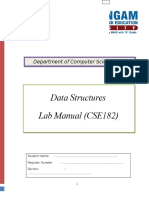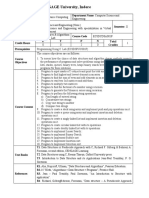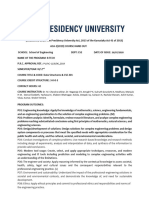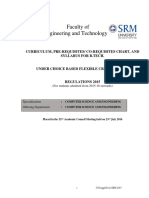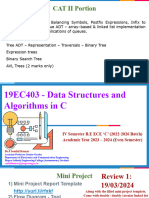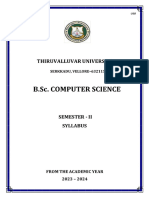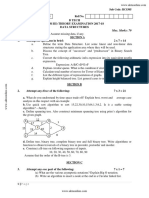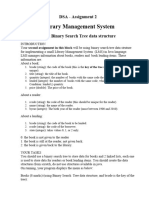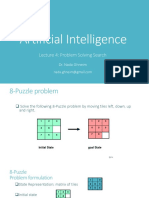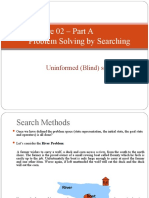School of Engineering and Technology (B.
Tech)
Course Delivery Plan: AY- 2024-2025
Course Title: Fundamentals of Data Structure
Course Code: 24BTELY106 Semester: I
Course Credit Structure: L:T:P:C - 4:3:2:0 Total Contact Hours: 50T, 10L
Course Coordinator: Dr. Swetha K B Course Faculty: Dr. Swetha K B
Ms. Vijayalakshmi H R
Ms. Panchami
Mrs. Roopa T
Mrs. Sailaja A
Mrs Nithya
Continuous Internal Assessment (CIA ) Marks:50 Semester End Examinations(SEE) Marks:50
I: PROGRAM OUTCOMES
PO No. POs Description
PO-1 Engineering knowledge: Apply the knowledge of mathematics, science,
engineering fundamentals, and an engineering specialization to the solution of
complex engineering problems.
PO-2 Problem analysis: Identify, formulate, review research literature, and analyze
complex engineering problems reaching substantiated conclusions using first
principles of mathematics, natural sciences, and engineering sciences.
PO-3 Design/development of solutions: Design solutions for complex engineering
problems and design system components or processes that meet the specified
needs with appropriate consideration for the public health and safety, and the
cultural, societal, and environmental considerations.
PO-4 Conduct investigations of complex problems: Use research-based knowledge
and research methods including design of experiments, analysis and
interpretation of data, and synthesis of the information to provide valid
conclusions.
1
� PO-5 Modern tool usage: Create, select, and apply appropriate techniques, resources,
and modern engineering and IT tools including prediction and modeling to
complex engineering activities with an understanding of the limitations
PO-6 The engineer and society: Apply reasoning informed by the contextual
knowledge to assess societal, health, safety, legal and cultural issues and the
consequent responsibilities relevant to the professional engineering practice.
PO-7 Environment and sustainability: Understand the impact of the professional
engineering solutions in societal and environmental contexts, and demonstrate
the knowledge of and need for sustainable development.
PO-8 Ethics: Apply ethical principles and commit to professional ethics and
responsibilities and norms of the engineering practice.
PO-9 Individual and teamwork: Function effectively as an individual, and as a member
or leader in diverse teams, and in multidisciplinary settings.
PO-10 Communication: Communicate effectively on complex engineering activities with
the engineering community and with society at large, such as, being able to
comprehend and write effective reports and design documentation, make
effective presentations, and give and receive clear instructions.
PO-11 Project management and finance: Demonstrate knowledge and understanding of
the engineering and management principles and apply these to one's own work,
as a member and leader in a team, to manage projects and in multidisciplinary
environments.
PO-12 Life-long learning: Recognize the need for, and have the preparation and ability
to engage in Independent and life-long learning in the broadest context of
technological change.
II: PROGRAM SPECIFIC OUTCOMES
PSO No. PSO Description
PSO1:
PSO2:
PSO3:
PSO4:
2
� III: COURSE OBJECTIVES
Sl. No. Description of Objectives
1 To impart knowledge of fundamental data structures and how they are
implemented.
2 To comprehend the significance of data structures in the context of creating
effective software.
3 To gain the ability to use the right data structures for addressing problems.
IV: COURSE CONTENT (SYLLABUS)
Module Topics Hours
Introduction to Algorithm and Data Structures
Algorithms, Asymptotic notations, Introduction to data structures, Types of
I data structures
Arrays: Introduction — Types of Arrays — Representation of One-
Dimensional Array in Memory— Array Traversal — Insertion and Deletion 10
— Sorting and Searching — Representation of Multi-Dimensional Array in
Memory — Realizing Matrices Using Two-Dimensional Arrays — Matrix
Operations
II Linked Lists, Stacks
Linked Lists — Introduction — Linked Lists Basic Concept — Linked
List Implementation — Types of Linked Lists — Circular Linked List —
Doubly Linked List 10
Stacks — Introduction — Stacks — Stack Operations — Stack
Implementation
Queues
III Queues — Introduction — Queues Basic Concept — Queue Operations
10
—Queue Implementation — Circular Queue — Priority Queue —Double-
Ended Queues
IV Trees
Trees — Introduction — Basic Concept — Binary Tree — Binary Tree
Representation — Binary Tree Traversal — Binary Search Tree — Tree 10
Variants
Graphs, Sorting and Searching 10
3
� V Graphs — Introduction — Basic Concept — Graph Terminology —
Graph Implementation — Shortest Path Algorithm — Graph Traversal
Sorting and Searching — Introduction — Sorting Techniques —
Searching Techniques
VI COURSE RESOURCES
A) TEXT BOOKS
1. Data structures using C , E Balagurusamy, McGraw Hill education (India) Pvt. Ltd,
2013.
B) REFERENCE BOOKS
1. Reema Thareja, Data Structures using C, 3rd Ed, Oxford press, 2012.
2. Robert Kruse, C.L.Tondo, Bruce Leung, Shashi Mogalla, “Data Structures and Program
Design using C”, Pearson Education, 2009
3. Ellis Horowitz and Sartaj Sahni, Fundamentals of Data Structures in C, 2nd Ed,
Universities Press, 2014.
C) E-LEARNING RESOURCES:
1. https://www.javatpoint.com/data-structure-in-c
2. https://www.programiz.com/dsa
3. https://www.javatpoint.com/data-structure-tutorial
V: List of Experiments
Fundamentals of Data Structure
Course Outcomes:
CO1 Determine the various C programming language data structures.
CO2 Evaluate how data structures are used to solve problems.
CO3 Put data structures into practice with the C programming language.
CO4 Assess the control structures, algorithmic notations, array representation as a
stack, insertion and deletion into a singly linked list, operation on a queue, and tree
height balancing.
1 Write a menu driven C program to perform the following string operations using pointers (i)
String Length (ii) String Concatenation(iii) string reverse
2 Write a program to find the location of a given number using Linear search.
3 Write a C program to search for an element in an array using Binary search
4 Write a C program to sort a list of N elements using Selection Sort Algorithm.
5 Write a C program to construct a singly linked list and perform insertion at the beginning,
deletion at the specified position and display the elements.
6 Write a C program to demonstrate the working of stack using arrays.
7 Write a C program for Towers of Hanoi problem using Recursion.
4
�8 Write a C program to create and traverse a binary search tree.
9 Write a C program to demonstrate the following operations in an array
(i) insertion of an element (ii) deletion of an element (iii) traversal
10 Write a C program to sort a list of elements using Bubble sort algorithm
11 Write a C program to sort a list of N elements using Insertion Sort Algorithm.
12 Write a C program to simulate the working of Linear Queue using a linked list.
13 Write a C program to search for a given element in a sorted linked list
14 Write a C program to implement stack operations using Linked list.
15 Write a C program to create a directed graph using Adjacency Matrix.
VII: COURSE SCHEDULE
Module Planned Starting Planned Total No. of Remarks
Date Concluded Hours (Completed- Y/N)
Date
1. 10
2. 10
3. 10
4. 10
5. 10
Remarks Note:
VIII : DETAILED SCHEDULE OF INSTRUCTION
Session
Sl. Bloom's COs Teaching Text
no Topics to be Remark
N Taxonom Covere Pedagogie Book
(Lecture covered s
o y d s
)
MODULE 1: Introduction to Algorithm and Data Structures
Algorithms, Chalk and
1 1 L1 CO1 T1
Asymptotic notations Talk & PPT
Introduction to data L1
Chalk and
2 2 structures, Types of CO1 T1
Talk & PPT
data structures
Arrays: Introduction L1 Chalk and
3 3 CO1 T1
, Types of Arrays Talk & PPT
5
� Representation of L2
Chalk and
4 4 One-Dimensional CO1 T1
Talk & PPT
Array in Memory
Array Traversal , L2 CO1 Chalk and
5 5 Insertion and T1
Talk & PPT
Deletion
Sorting and L1 CO1 Chalk and
6 6 T1
Searching Talk & PPT
Representation of L2 CO1 Chalk and
7 7 Multi-Dimensional T1
Talk & PPT
Array in Memory
Realizing Matrices L3 CO1 Chalk and
8 8 T1
Using Two- Talk & PPT
L3 CO1 Chalk and
9 9 Dimensional Arrays , T1
Talk & PPT
CO1 Chalk and
10 10 Matrix Operations L4 T1
Talk & PPT
MODULE 2: Linked Lists, Stacks
Introduction — CO2 Chalk and
11 11 Linked Lists Basic L1 T1
Talk & PPT
Concept
Linked List CO2 Chalk and
12 12 L2 T1
,Implementation Talk & PPT
Types of Linked CO2
Chalk and
13 13 Lists Circular Linked L2 T1
Talk & PPT
List
CO2 Chalk and
14 14 Doubly Linked List L2 T1
Talk & PPT
— Introduction — CO2 Chalk and
15 15 L1 T1
Stacks Talk & PPT
CO2 Chalk and
16 16 Stack Operation L2 T1
Talk & PPT
Stack CO2 Chalk and
17 17 L5 T1
Implementation Talk & PPT
Stack CO2 Chalk and T1
18 18 L5
Implementation Talk & PPT
19 19 Stack L5 CO2 Chalk and T1
6
� Implementation Talk & PPT
Stack CO2 Chalk and T1
20 20 L5
Implementation Talk & PPT
MODULE 3: Queues
Introduction — CO3
Chalk and
21 21 Queues Basic L1 T1
Talk & PPT
Concept
CO3 Chalk and
22 22 Queue Operation L2 T1
Talk & PPT
Queue CO3 Chalk and
23 23 L5 T1
implementation Talk & PPT
CO3 Chalk and
24 24 Circular Queue L3 T1
Talk & PPT
CO3 Chalk and
25 25 Priority Queue L2,3 T1
Talk & PPT
Double- Ended CO3 Chalk and
26 26 L2 T1
Queues Talk & PPT
CO3 Chalk and T1
27 27 Implementation L5
Talk & PPT
CO3 Chalk and T1
28 28 Implementation L5
Talk & PPT
CO3 Chalk and T1
29 29 Implementation L5
Talk & PPT
CO3 Chalk and T1
30 30 Implementation L5
Talk & PPT
MODULE 4: Trees 21
Introduction — Chalk and
31 31 L1 CO4 T1
Basic Concept Talk & PPT
Binary Tree — CO4 Chalk and
32 32 Binary Tree L2 T1
Talk & PPT
Representation
Binary Tree CO4 Chalk and
33 33 L3 T1
Representation Talk & PPT
Binary Tree L4 CO4 Chalk and
34 34 T1
Traversal Talk & PPT
7
� Binary Tree L4 CO4 Chalk and
35 35 T1
Traversal Talk & PPT
L1 CO4 Chalk and
36 36 Binary Search Tree T1
Talk & PPT
L2 CO Chalk and
37 37 Binary Search Tree T1
Talk & PPT
L2 CO4 Chalk and
38 38 Binary Search Tree T1
Talk & PPT
L5 CO4 Chalk and
39 39 Lab Programs T1
Talk & PPT
L4 CO4 Chalk and
40 40 Tree Varients T1
Talk & PPT
MODULE 5: Graphs, Sorting and Searching
Introduction — L1 Chalk and
41 41 CO4 T1
Basic Concept Talk & PPT
L1 Chalk and
42 42 Graph Terminology CO4 T1
Talk & PPT
Graph L4 Chalk and
43 43 CO4 T1
Implementation Talk & PPT
Graph L4 Chalk and
44 44 CO4 T1
Implementation Talk & PPT
Shortest Path L4 Chalk and
45 45 CO4 T1
Algorithm Talk & PPT
L4 Chalk and
46 46 Graph Traversal CO4 T1
Talk & PPT
L4 Chalk and
47 47 Graph Traversal CO4 T1
Talk & PPT
Introduction to L2
Sorting and Chalk and
48 48 CO4 T1
searchingTechnique Talk & PPT
s
Sorting Techniques L2 CO4 Chalk and T1
49 49
Talk & PPT
Searching L2 CO4 Chalk and T1
50 50
Techniques Talk & PPT
8
� IX: LABORATORY SCHEDULE
Planned Planned Total
Sl Starting Ending Number
No Activity Date Date of hrs
1. Write a menu driven C program to perform the 2
following string operations using pointers (i) String
Length (ii) String Concatenation(iii) string reverse
2. Write a program to find the location of a given number 2
using Linear search.
Write a C program to search for an element in an
array using Binary search.
3. Write a C program to sort a list of N elements using 2
Selection Sort Algorithm.
4. Write a C program to construct a singly linked list and 2
perform insertion at the beginning, deletion at the
specified position and display the elements.
5. Write a C program to demonstrate the working of 2
stack using arrays.
Write a C program for Towers of Hanoi problem using
Recursion.
6. Write a C program to create and traverse a binary 2
search tree.
7. Write a C program to demonstrate the following 2
operations in an array
(i) insertion of an element (ii) deletion of an element
(iii) traversal
8. Write a C program to sort a list of elements using 2
Bubble sort algorithm
Write a C program to sort a list of N elements using
Insertion Sort Algorithm.
9. Write a C program to simulate the working of Linear 2
Queue using a linked list.
Write a C program to search for a given element in a
sorted linked list.
10. Write a C program to implement stack operations 2
using Linked list.
Write a C program to create a directed graph using
9
� Adjacency Matrix.
X: COURSE OUTCOMES
At the end of Course Students will be able to,
Sl. POs No.
No CO’s
1. Determine the various C programming language data structures.
2. Evaluate how data structures are used to solve problems.
3. Put data structures into practice with the C programming language.
4. Assess the control structures, algorithmic notations, array representation as
a stack, insertion and deletion into a singly linked list, operation on a queue,
and tree height balancing.
*CORRELATION: H (High):3, M (medium):2 and L (low):1
XI: MAPPING OF CO WITH PO
CO/PO PO1 PO2 PO3 PO4 PO5 PO6 PO7 PO8 PO9 PO10 PO11 PO12
CO1 2 2 2 - - - - - - - - -
CO2 2 2 2 1 - - - - 1 - - 1
CO3 3 2 2 1 2 - - 1 - 2 - 1
CO4 1 2 - - 2 - - 2 2 2 - 1
XII: MAPPING OF CO WITH PSO
CO. No PSO1 PSO2 PSO3 PSO4 PSO5
CO1
10
� CO2
CO3
CO4
CO5
XIII: ASSESSMENT AND EVALUATION PATTERN:
Assessment Components Details
a) Test – I Each Continuous Assessment (CA) will
be conducted for 30 marks and scale
Test – II down to 10
( Total Test Marks 20 = T1 + T2)
Continuous Lab Lab Continuous Assessment (CA) will
Internal be conducted for 20 marks
Assessment Lab Class
Performance
10 Marks
/Quiz/Record/Mini
Project etc.
Total CA 50 Marks
b) Semester End Examinations 50 Marks
Signature of the Course Coordinator Signature of the Chairperson DAC
Signature of the Dean
11























